App rank shows which place in a queue of search results your app takes when it is searched with a specific keyword.
Knowing effective search terms is a must-do for adjusting the semantics of your app’s text assets. When you know for which keywords your app is ranked higher or lower, you can change your ASO strategy, deleting or adding keywords to your semantics. By using popular search terms, you can attract more users.
Several services allow you to check the app’s rank, although only a few allow you to cover all the ASO steps. For example, Asolytics offers an all-around ASO workflow with huge keyword limits and no limits for the number of countries and competitors. In this article, we’ll show you an effective way to check all the keywords for which your app is ranked using Asolytics tools.
You can try Asolytics’ app rank tracker tools for free. Checking any app will take up to 5 minutes of your time. Asolytics offers three tools to check app rankings:
App Ranking tool
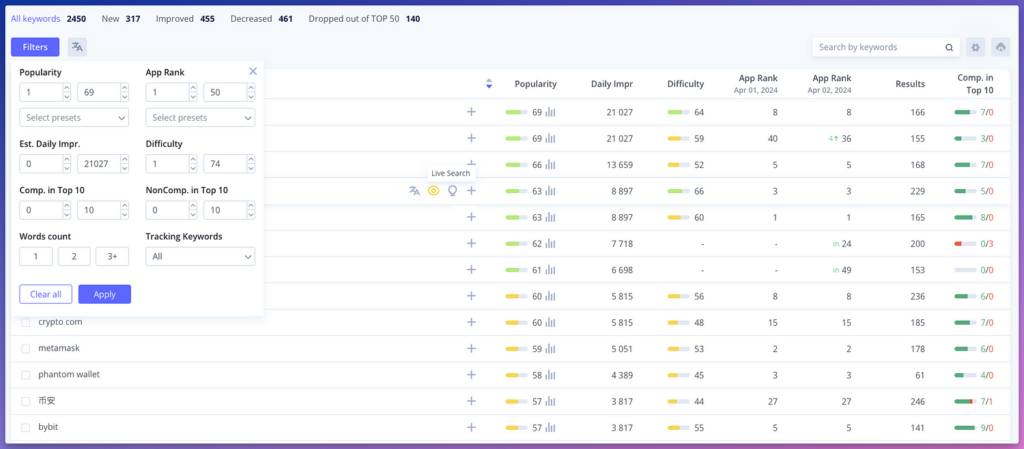
Rank Comparative report
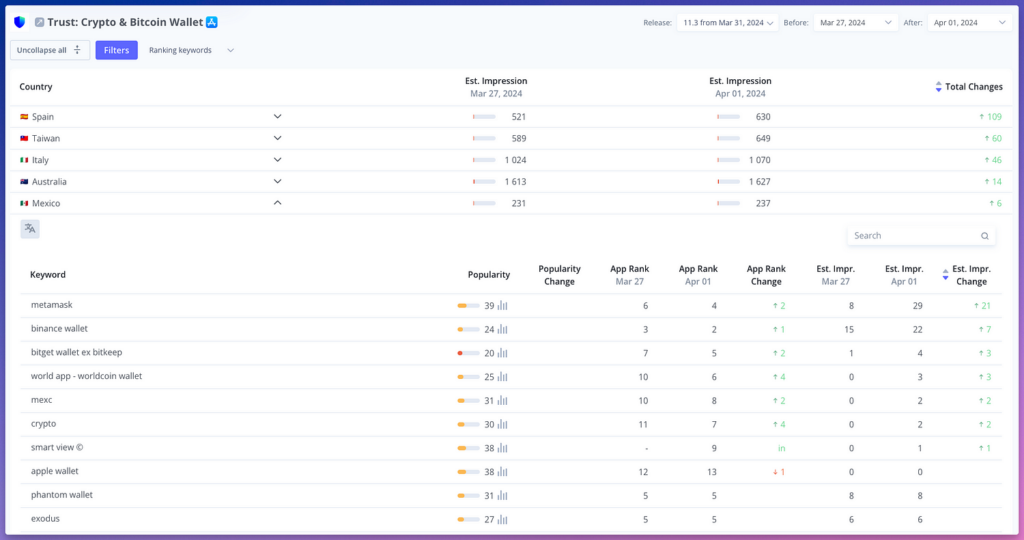
Impressions report
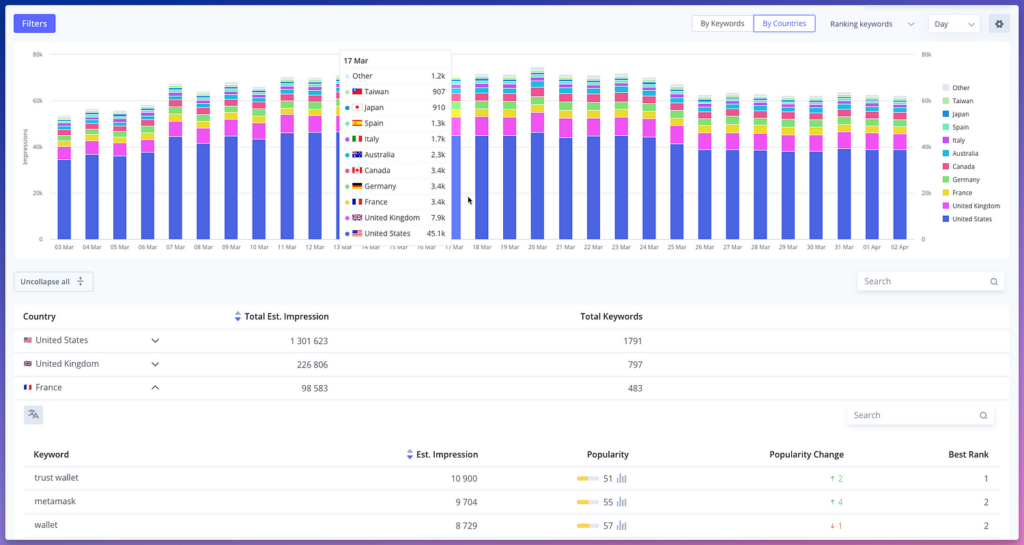
You can use every tool separately or together to gather as much detail as possible in convenient tables, compare data historically, or filter data by metrics, and more. You can use the quick guide or extended tutorial for each tool. Also, you can download reports in spreadsheets from each of these tools.
BTW, besides showing you practical tools to check app rank, in this article, we will provide you with comprehensive info about app rank, how it differs in the App Store and Google Play, all the possible ways to check it, how to increase app rank, and how app rank affects your ASO. This is literally the most comprehensive and up-to-date guide on app rank.
In this guide, you’ll find out:
- How to check any app rank quickly; how to get all the possible data about app rankings
- Difference between app ranking in the App Store and Google Store
- How often you should check app ranks, and how to adjust your ASO
- How to use app market trends to increase your app ranking
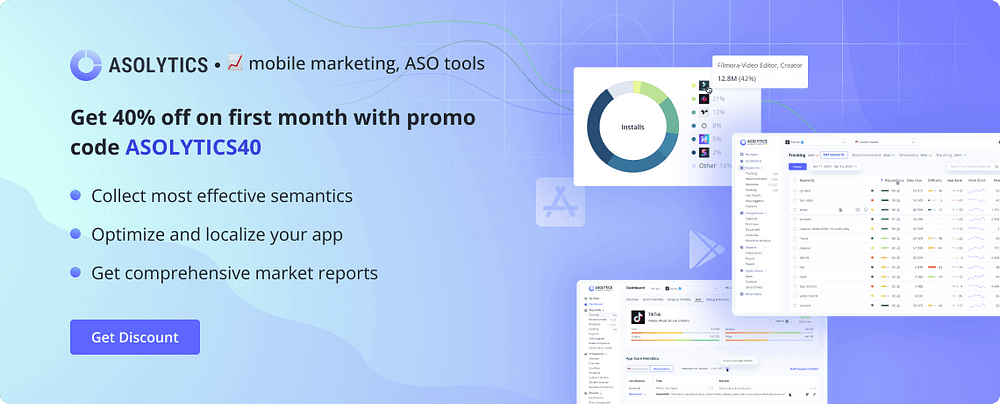
Top 3 Tools to Check App Rank in Asolytics
The App Ranking, Rank Comparative, and Impressions tools have specifics. All of them retrieve constantly updated data about app rankings from the App Store and Google Play and all countries. Also, each tool shows data in user-friendly tables with filters for each metric.
Before giving you instructions on how to use each tool, let’s see how you can benefit from them.
App Ranking tool
Goal: Deep app ranks analysis. Collecting semantics. Adjusting semantics.
Use this tool to analyze all the keywords for which the app is ranked. It will help you collect effective semantics for your app.
This tool shows the total number of keywords the app is ranked for. You can choose any app, country, or date. You can also quickly switch to any other app from the store, including apps from your competitors’ list.
You’ll get metrics for each keyword. In addition, all the ranking keywords are divided into sections (ones that improve your app positions, ones that decrease app positions, new ones, and those that dropped from the top 50).
Asolytics App Ranking pros:
- No daily or monthly limits: check as many apps and countries as you want;
- Fast switch between competitors ranking keywords;
- See historical data, check rankings for any date you want, and compare with any other date;
- A lot of keyword filters;
- See how many competitors rank on each keyword;
- Check live search results from the store, store autosuggest, and translate keywords from different languages in English;
- Two dates compare mode.
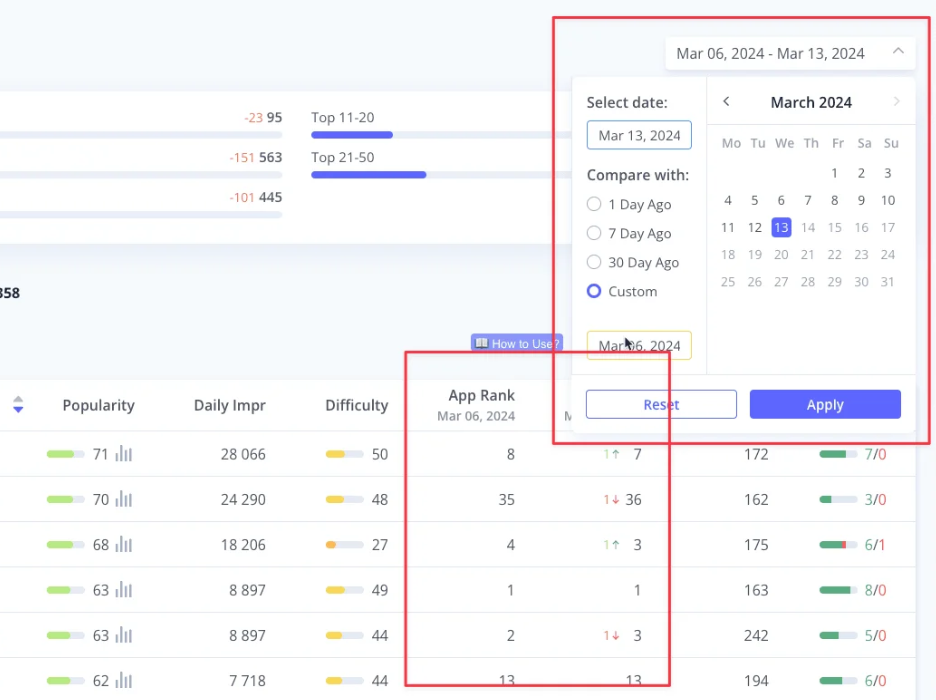
Rank Comparative report
Goals: App rank comparison by date and country. Semantics adjustment. App localization., Benchmarking Metadata Release Update.
Use this tool to compare app rankings, estimated search impressions by two date and multiple countries simultaneously. This tool is similar to App Ranking and shows all the keywords your app ranks for. The Rank Comparative report aims to compare keyword effectiveness by particular dates and countries. Moreover, you can see the impressions your app gets for each keyword and any date and country.
The Rank Comparative report will help you make decisions about adjusting your app’s semantics over time and localizing it.
Tip: Particular keywords can rank your app differently in different countries. With the Rank Comparative report, you can discover countries where your app is ranked higher for a specific search term - this will help you localize your app more effectively.
Rank Comparative pros:
- Work with many countries at once;
- See not only positions but also estimates of search impressions;
- You can analyze impressions and positions of your semantic core in different countries;
- A quick way to analyze how your metadata update worked in different countries.
Rank Comparative Report quick guide
- Choose an app you want to analyze (quickly select from your apps, your competitors, or find any app from the store).
- Select markets: Worldwide, Region, or specific countries.
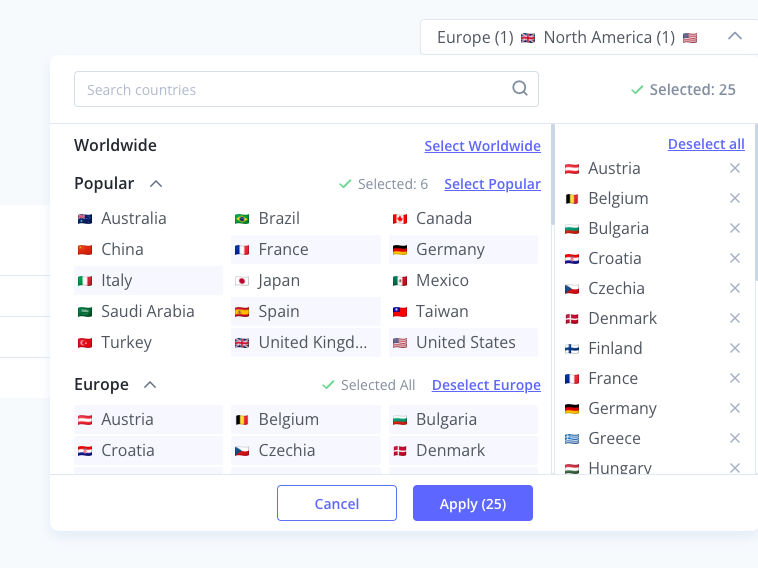
![]() Select one of your latest releases or manually choose dates to compare.
Select one of your latest releases or manually choose dates to compare.
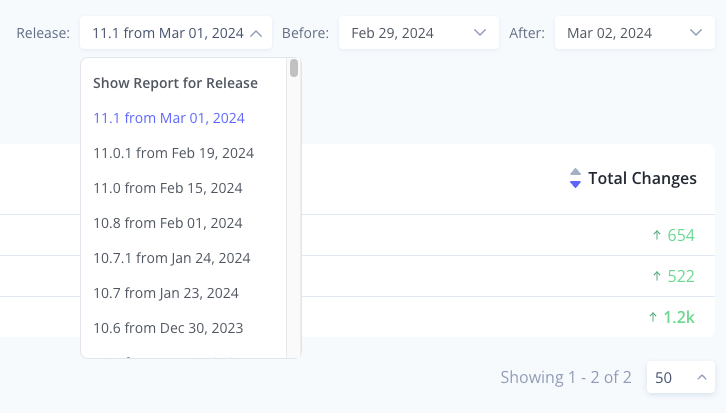
![]() Select rank mode. You can generate a report with all ranking keywords or by tracking keywords from your semantic core.
Select rank mode. You can generate a report with all ranking keywords or by tracking keywords from your semantic core.
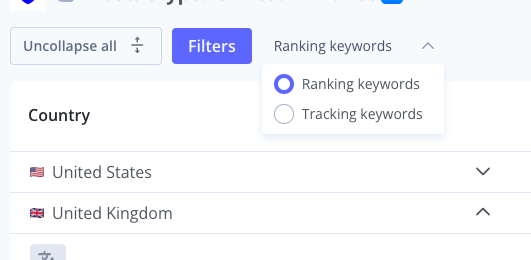
![]() Now, you can see estimated impressions for the first and second dates in different countries and see detailed information about keywords, positions, and impressions.
Now, you can see estimated impressions for the first and second dates in different countries and see detailed information about keywords, positions, and impressions.
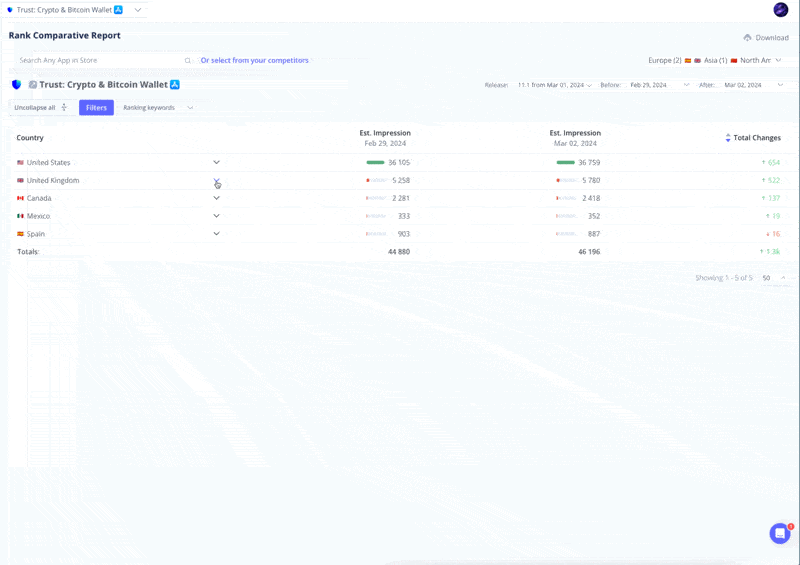
Impressions report
Goals: Search results analysis. Complete search Impressions analysis impressions chart.
Use this tool to see the dynamics of impressions the app gets throughout countries and on different days.
Impressions Report pros
- See the dynamic of app ranking: This gives a clear picture of app search popularity, it’s better than comparing two dates.
- Analyze search impressions, not app positions: This is a better metric that gives a better understanding of the app’s popularity in search.
Impressions Report quick guide
- You can check impressions report for a certain period of time for countries:
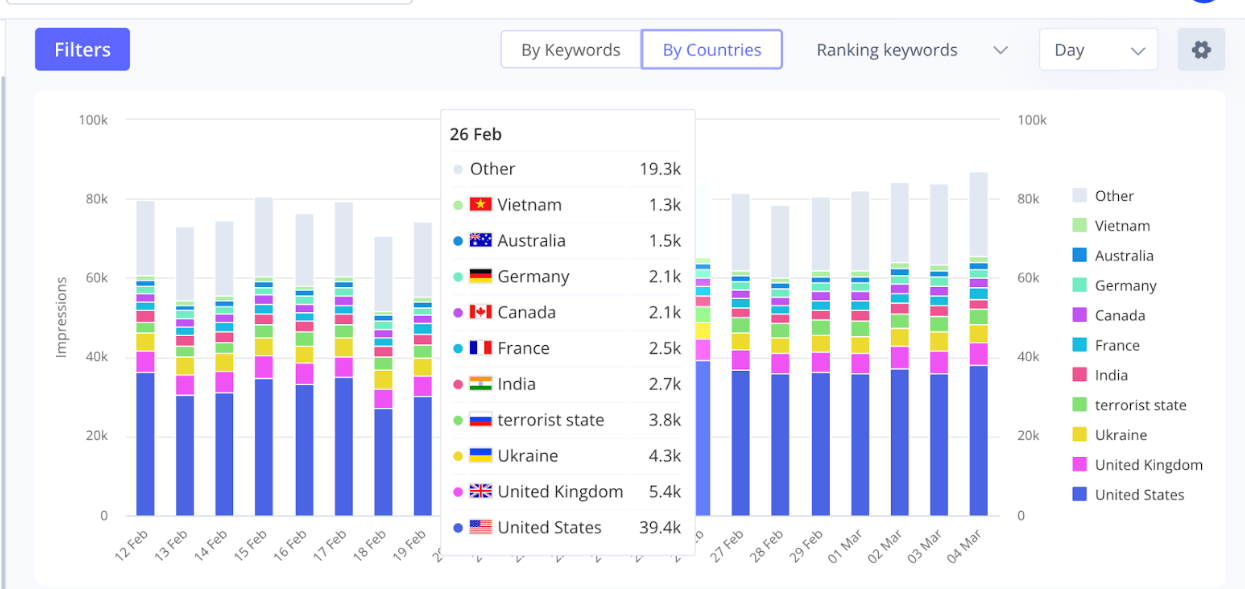

![]() Or switch to Keywords Mode and see which keywords brought the most search impressions in all countries at once.
Or switch to Keywords Mode and see which keywords brought the most search impressions in all countries at once.
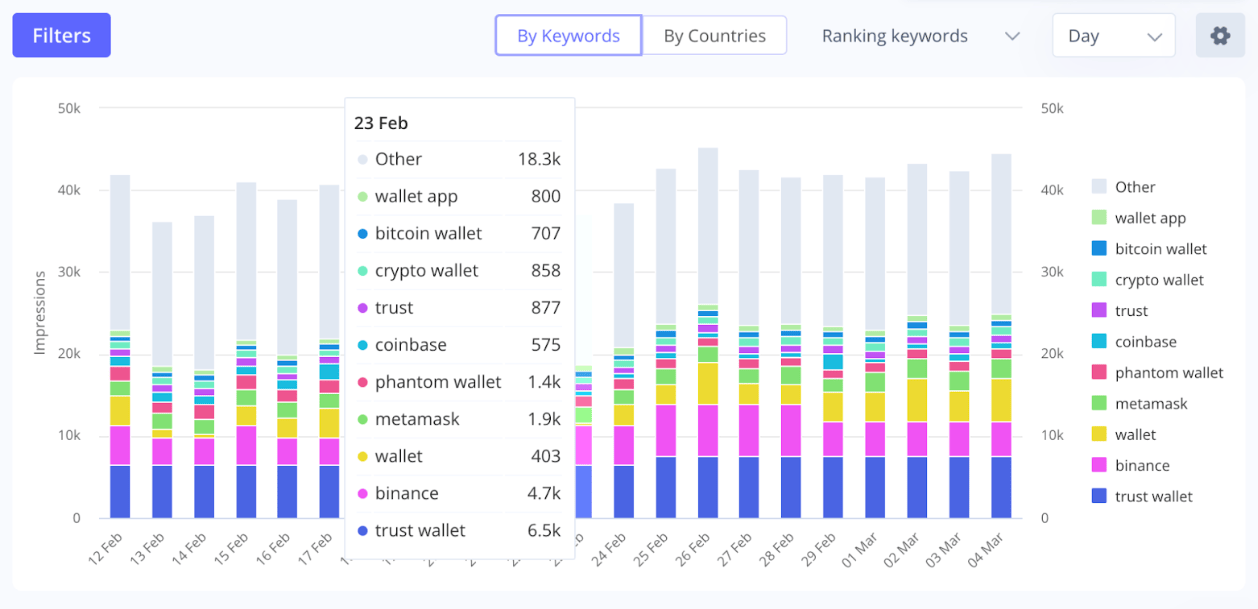
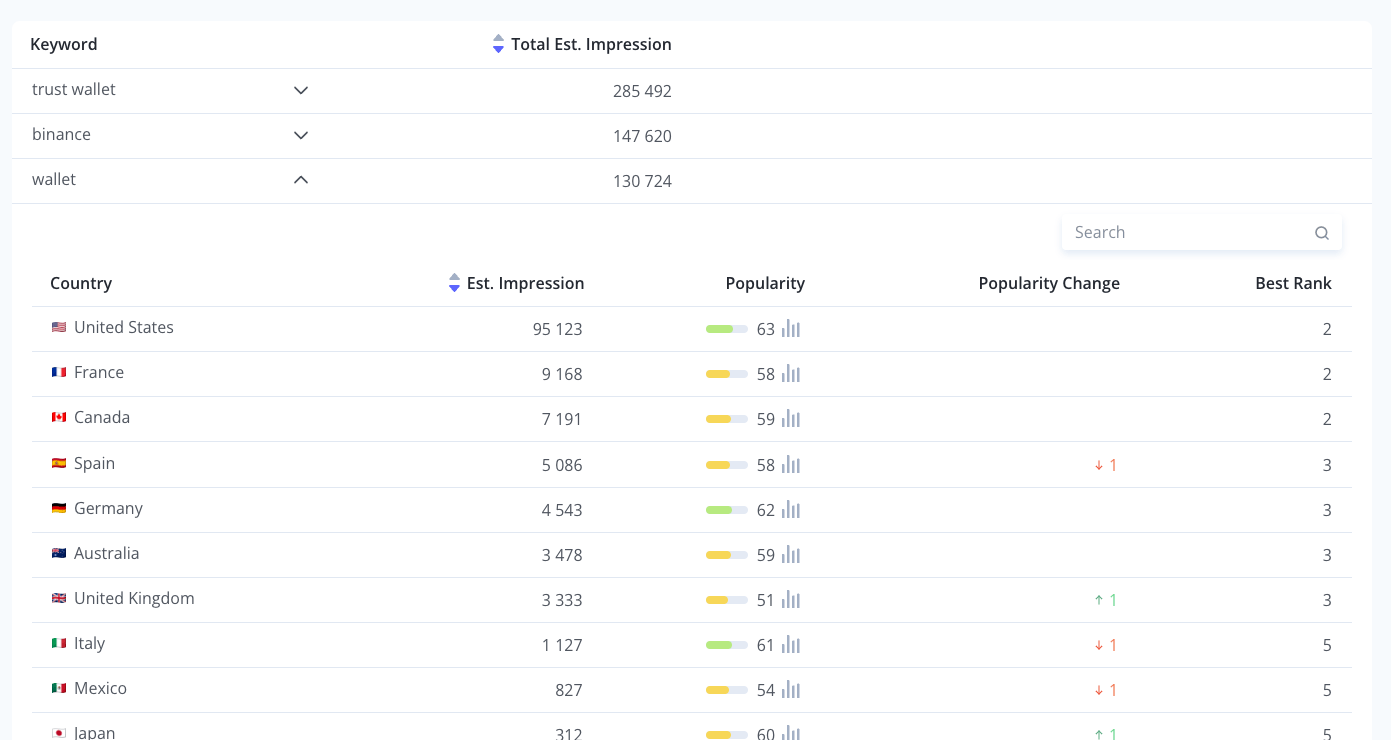
Remember that app rankings change daily, and it’s important to reveal keywords that may increase your app’s position.
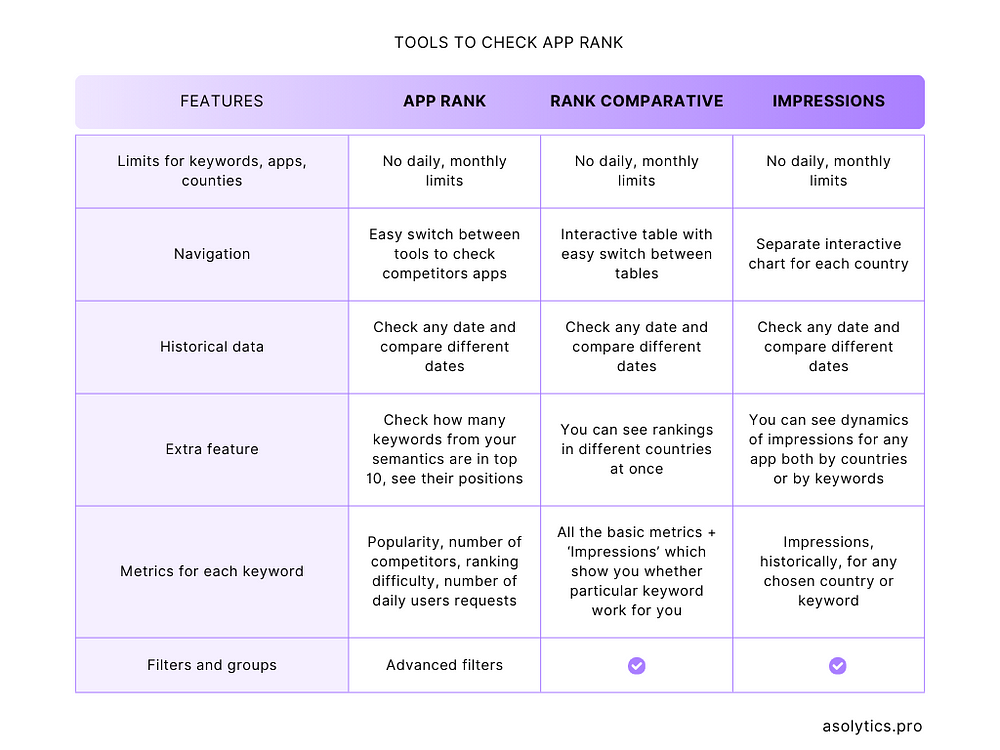
How to Check App Rankings with Asolytics: Quick Wrap-Up
Add primary data about the app (3 minutes):
- Go to Asolytics tools. You’ll have to register — it’s free and fast. You can use all the tools for free as soon as you are in.
- Choose the country and app store. The Asolytics database includes all the available apps in the App Store and Google Play. Select any app from the list.
- Add three keywords that relate to the chosen app. They can be any words that best describe this app. Also, they represent search terms with which users usually look for this app.
At this point, you can dive into the full-fledged ASO workflow, from collecting semantics and improving your app’s metadata to market research and app localization. However, this guide aims to show you how to check app rank. Let’s start with completing this specific task.
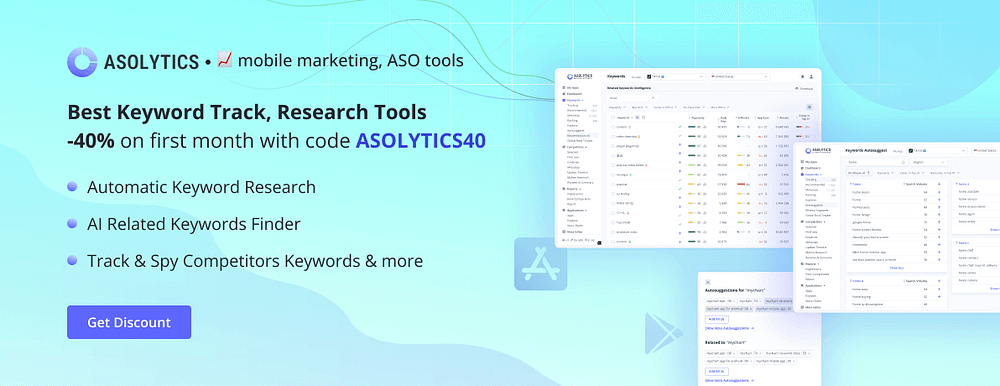
Use the App Ranking tool to get all the keywords your app is ranked for (up to 5 minutes):
![]() Open the Ranking tool in the Tracking section. You’ll see a list of keywords with detailed metrics. Click the’ Plus’ button to add effective search terms to your semantics.
Open the Ranking tool in the Tracking section. You’ll see a list of keywords with detailed metrics. Click the’ Plus’ button to add effective search terms to your semantics.
You’ll get the following metrics:
- Total number of ranking keywords and their dynamics;
- Number of keywords for which your app is ranked in TOPs;
- Separate groups of Improved, Decreased, and New keywords;
- Keyword popularity, impressions, difficulty, ranks on specific dates, and number of competitors for a specific keyword in the TOP 10 apps.
Tip: Check app rankings regularly to check for which keywords your app was ranked higher or lower.
Use the Rank Comparative report to compare app positions for keywords by dates and countries (up to 5 minutes)
![]() Go to the Rank Comparative report on the side panel. Select all the countries and dates you are interested in. For each country, you’ll get a comprehensive report about how keyword efficacy changed during a selected period.
Go to the Rank Comparative report on the side panel. Select all the countries and dates you are interested in. For each country, you’ll get a comprehensive report about how keyword efficacy changed during a selected period.
You’ll see the following data:
- List of all the keywords the app is ranked with (for each country);
- Keyword popularity and its dynamics;
- App rank on specific dates;
- App rank change (i.e., how many positions the app lost or got for this keyword recently);
- Impressions on specific dates and their dynamics.
Use the Impressions report to see how many times your app’s been seen for a specific search term (up to 5 minutes)
![]() Choose a period (any day, week, or month). Then, choose which app ranking data you want to see first: by keyword or country. You can also apply a filter for keyword impressions, popularity, and rank.
Choose a period (any day, week, or month). Then, choose which app ranking data you want to see first: by keyword or country. You can also apply a filter for keyword impressions, popularity, and rank.
After this, you’ll see the chart showing how many impressions your app got for a specific keyword or in a specific country. It explains how many times users saw your app while using particular search terms.
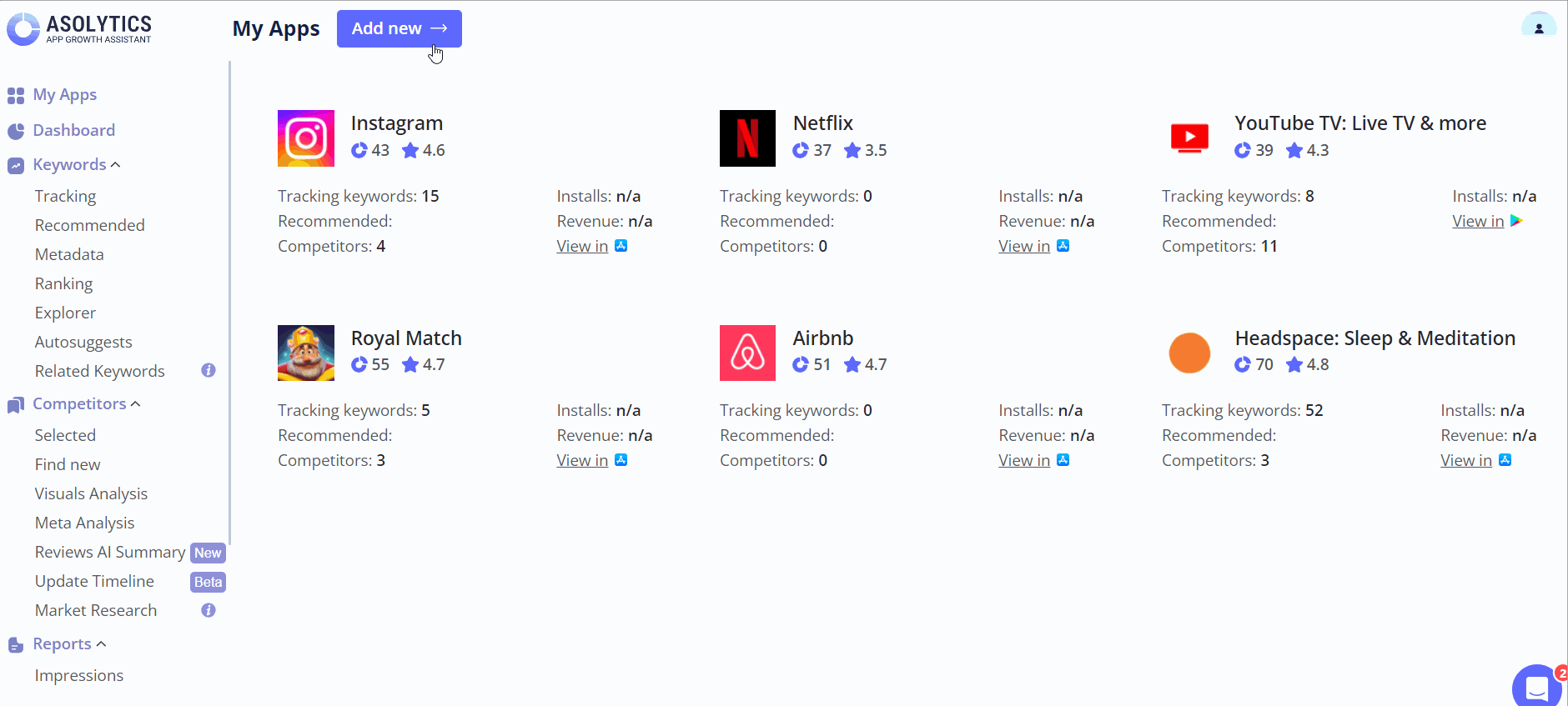
Note that you can analyze any app and any country with these tools. Also, you can apply filters for any tool we’ve discussed.
Now you know how to check app rankings flawlessly with Asolytics ASO tools. To ensure that you know how to apply these data to your ASO strategy, read the theory section below. It will help you understand why app rank is important, how often it changes, and whether there is any difference between app rank in the App Store and Google Play.
What Affects App Rank in the Apple App Store
Understanding how the Apple App Store ranks applications is crucial for developers and marketers aiming to boost their app’s visibility. However, the App Store does not clarify all ranking factors. It is essential for fair app competition. Based on ASO observations and information provided by App Store, we made a list of factors that may have the most weight in app ranking:
Keyword relevance
Keywords in an app’s title, subtitle, and description play a crucial role in its discoverability. Precise and relevant keywords can significantly boost an app’s visibility and ranking.
App downloads and velocity factor
The total number of downloads and the speed at which an app is downloaded play a significant role in its ranking. A high download rate signals popularity and relevance, encouraging the App Store to rank the app higher.
User ratings and reviews
User opinions matter greatly. Apps with higher ratings and positive reviews tend to rank better. These reflect user satisfaction, signaling to the App Store that an app is of high quality and worth promoting.
Tip: Asolytics recommends working with negative reviews and trying to increase the app’s ratings by at least 4.5 in all countries.
User engagement and retention
How frequently and how long users engage with an app influences its rank. High engagement and retention rates indicate a valuable app, which can positively affect its ranking.
Quality localization optimization
Apps optimized for multiple languages and regions (localization) can reach a broader audience, increase downloads, and improve their rank.
By understanding and optimizing these factors, developers, and marketers can strategically improve their app’s rank in the Apple App Store. It’s constantly tweaking and refining, keeping the user experience at the forefront to climb the ranks in the App Store’s listings.
App Ranking Difference: Apple App Store vs. Google Play
While the ultimate goal in both the Apple App Store and Google Play is to maximize an app’s visibility and user accessibility, the mechanisms and factors influencing app rank in these platforms have some differences. Here’s a comparative look at how app rank is determined on these two major platforms.
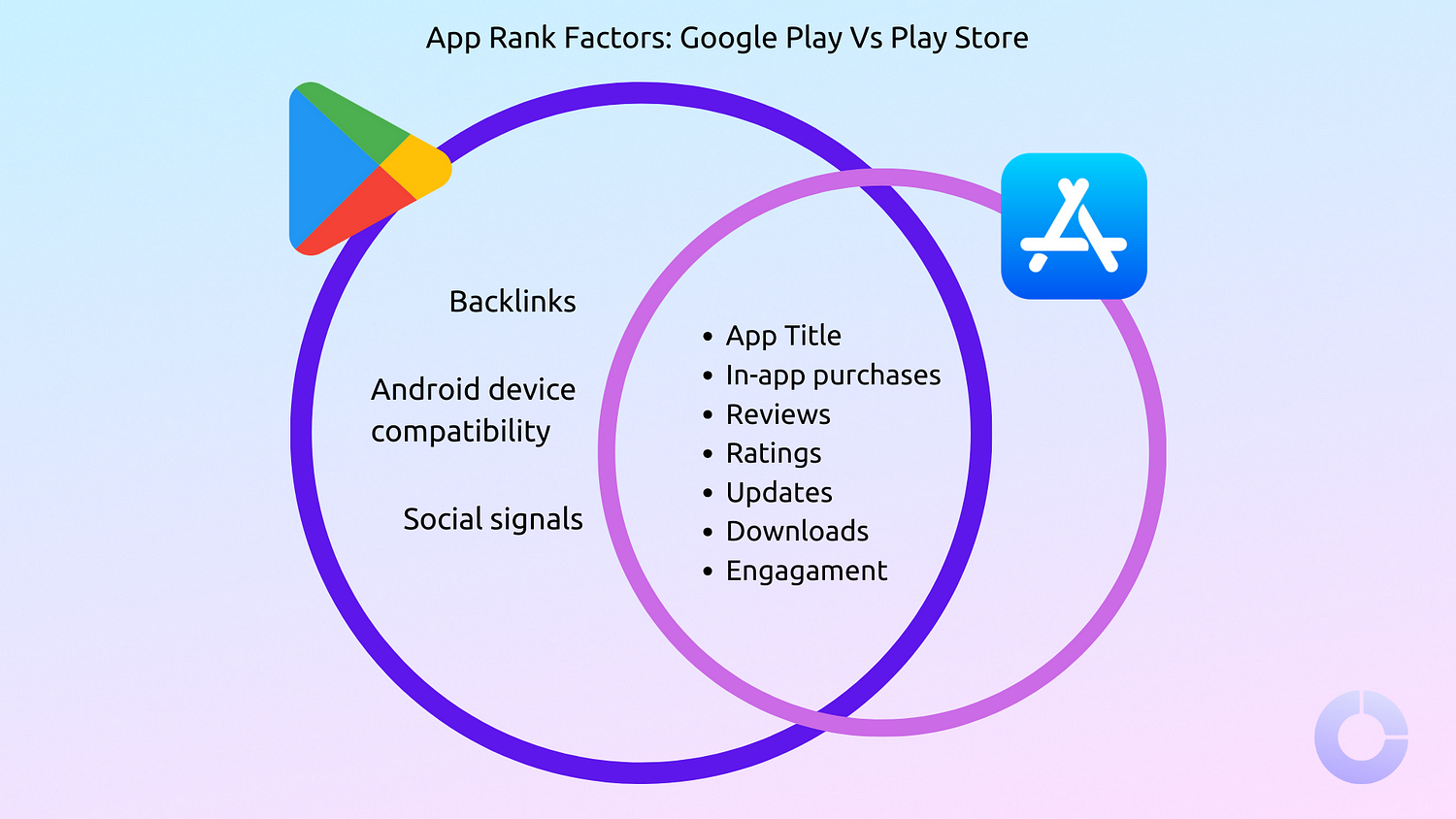
Key differences
Metadata and keywords
Both platforms value metadata for search visibility, but the way they handle and prioritize keywords differs. Apple is more straightforward, heavily weighting the app’s title, subtitle, and keyword field, whereas Google Play analyzes the app description for relevant keywords in a more nuanced manner: Google Play pays attention to keywords density and exact keyword match.
Also, Google Play takes into account long descriptions of apps while the App Store doesn’t. The App Store does not attach localization to the countries, while Google does. You can read more about localization specifics in the article: How to choose countries for app localization
Engagement vs. downloads
While both platforms may consider user engagement and download metrics, it seems that Google Play prioritizes how users interact with an app post-download, focusing on retention and user behavior. In contrast, the Apple App Store is thought to place significant importance on the number of downloads and download velocity, reflecting immediate popularity and demand.
Google Play ranks apps by keywords from users’ reviews, whereas App Store seems to not take the content of the reviews into account.
Personalization
Google Play takes a more personalized approach to ranking apps, leveraging Google’s extensive data on individual user preferences and behavior patterns. This means that two different users may see different rankings for the same search query, based on their past interactions and download history.
Quality signals
Google Play integrates broader quality signals, including system compatibility and backlinks, into its ranking algorithms. These factors, along with Google’s propensity to incorporate social signals, offer a multidimensional view of an app’s relevance and quality.
How to Check App Rank in the App Store and Google Play
You can monitor your app’s position within the Apple App Store and Google Play. You should remember that App Store shows the same search results for all users, while Google Play search results may differ due to users search history and customization. Knowing where your app stands in terms of ranking gives you insightful data that can be used to refine and enhance your app’s visibility and success.
How to check your app’s rank in the Apple App Store?
Use Apple’s search function
The simplest method to check your app’s rank is by searching for it directly in the Apple App Store using keywords associated with your app. This can give you a basic idea of where your app appears in search results for those terms.
Apple App Store connect
Apple’s official platform, App Store Connect, offers various analytics, including app performance metrics. While it doesn’t directly show ‘app rank,’ it provides valuable data on app downloads, user engagement, and revenue, which can indirectly indicate your app’s standing and visibility in the store.
How to check your app’s rank in Google Play?
Google Play console
Google’s official tool, the Google Play Console, provides developers with a wealth of data, including performance metrics such as installations, engagement, and retention rates. While it doesn’t directly display ‘app rank’, these metrics are closely related to your app’s visibility and can offer insights into how well your app is positioned.
Keyword searches
Performing searches on Google Play using keywords relevant to your app can give you a real-time snapshot of where your app stands in search results. This manual method is straightforward but requires consistent effort to track changes over time.
To get analytics from both the App Store and Google Play, you can use third-party platforms. Often, they offer more comprehensive data on app success in a particular store, app category, and country.
Third-party ASO tools
Several third-party services and platforms offer ranking tracking specifically designed for ASO purposes. They allow developers to analyze their app’s ranking for specific keywords, track changes over time, and receive alerts on ranking shifts. These tools can be especially beneficial for identifying which keywords are most effective in improving your app’s visibility. Asolytics is an ASO platform where you can not only analyze your app and competitors but also get insights and tips for building your ASO strategy.
Watch this 11-minute webinar to learn how to collect effective semantics to build an ASO strategy:
Competitor analysis
Understanding how your competitors are performing is vital. By using the same search and analysis tools, you can track competitors’ ranks and see how your app’s rank compares in the context of similar apps. This can help identify new opportunities for growth and optimization.
App Rank fluctuations: How often can App Rank change?
In the ever-evolving digital marketspace of mobile apps, app rankings are far from static. They are dynamic, reflecting real-time changes based on user behavior, market trends, updates, and algorithm shifts.
This fluidity means that an app’s rank can change daily, sometimes even more frequently. Understanding this volatility and knowing how to respond when your app loses position is critical to maintaining and improving your app’s visibility and success.
App ranks in both the Apple App Store, and Google Play can change multiple times throughout a single day.
A surge or drop in app downloads and user engagement can lead to swift changes in rank. New user reviews and changes in ratings impact your app’s perceived quality, affecting its rank. Updates, launches, or marketing campaigns by competitors can shift the rankings landscape. Both Google Play and the Apple App Store periodically update their ranking algorithms, potentially causing significant rank changes.
Given this fluidity, it’s vital for developers and marketers to monitor their app’s rank regularly, employing strategic responses to any downward trends. If your app experience app rank decreases, you should react, conduct research, and make changes in your ASO strategy.
What should you do in case of an app rank drop?
Step 1: Analyze the drop
Identify the potential causes of the rank drop. This could be due to negative reviews, a successful competitor launch, or changes in user behavior. Utilize analytics tools to pinpoint the timing and magnitude of the change.
Step 2: Enhance app quality and user experience
Address any technical glitches, optimize performance, and roll out features that meet users’ needs. Improving app quality and user experience can lead to better reviews and increased engagement, positively impacting your rank.
Step 3: Optimize ASO factors
Revisit your app’s title, description, keywords, and visuals. Ensure they are optimized based on current best practices for ASO. Regular updates in line with user search trends can help recover or improve your app’s position.
One of the ASO strategies is to localize your app properly — adapt it to the needs of different audiences. If done correctly, you will see boost of intalls around many countries.
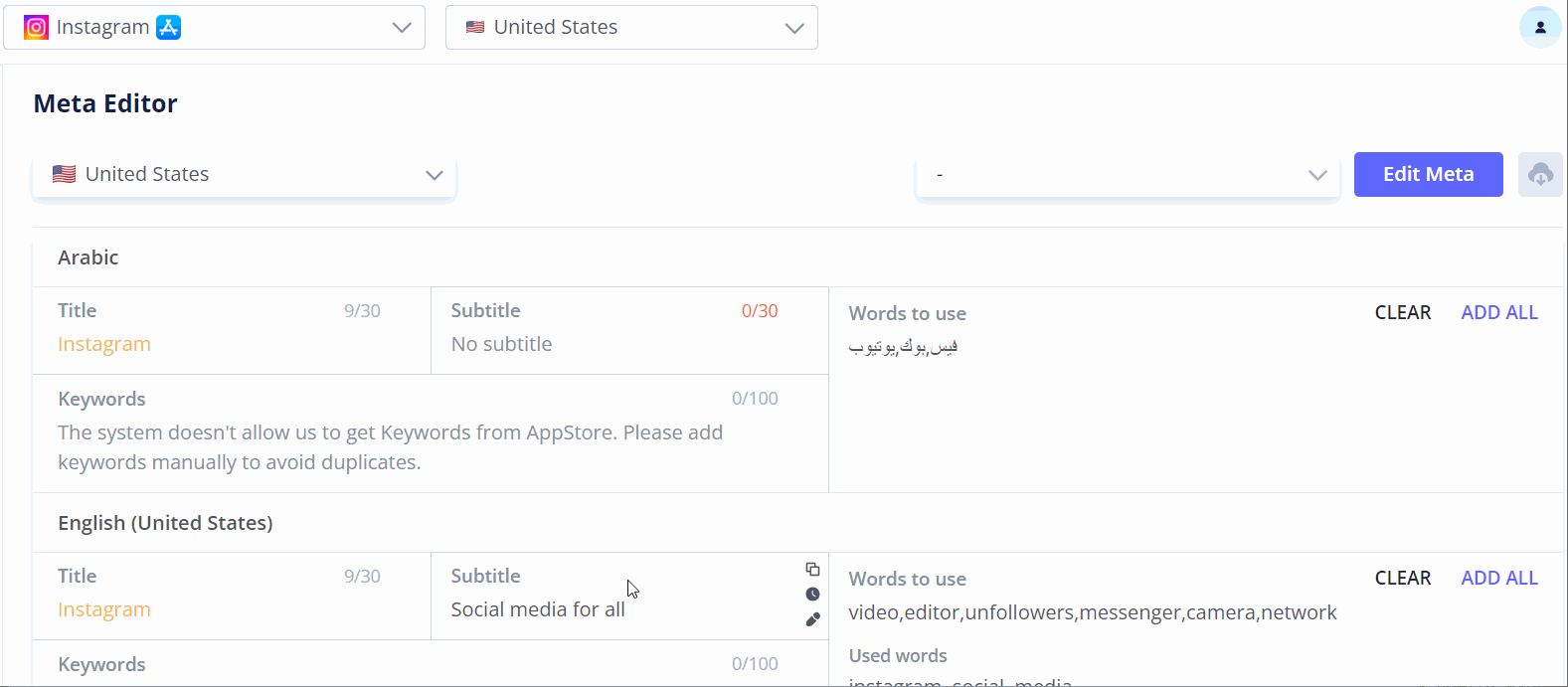
Step 4: Encourage positive reviews
Engage with your app users through in-app messages, emails, or social media, asking for feedback and reviews. Positive reviews can counterbalance negative ones and improve your app’s ranking.
Step 5: Monitor competitor activity
Keep an eye on what your competitors are doing. If a competitor’s app has overtaken yours, analyze what changes they have implemented. This could be in terms of app updates, user engagement strategies, or marketing efforts.
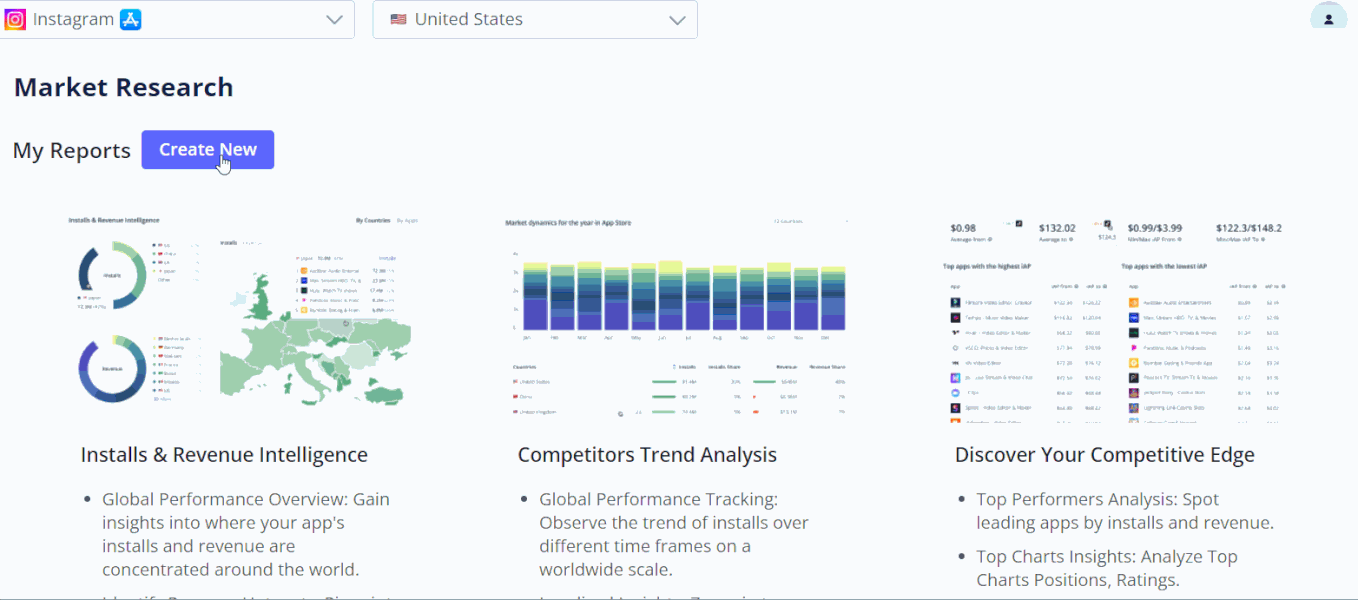
If you want to conduct comprehensive market research, use Market Research tool. Read this short tutorial about how to analyze competitors and market in general with this tool.
Step 6: Adjust your marketing strategy
Consider increasing your marketing efforts to boost app visibility and downloads. A well-timed ad campaign or engaging content on social media can reignite interest in your app.
Before introducing any major changes, it’s important to check in advance if they are relevant to your users’ needs. For this, the best method is to conduct a ASO split test.
Step 7: Continuous monitoring and adaptation
App rankings are not just about reaching the top but maintaining your position. Continuous monitoring, analysis, and adaptation of your ASO and marketing strategies are essential to navigate the dynamic app marketplace successfully.
The world of mobile apps is characterized by rapid changes and competition. A dip in app rank is not a defeat but a signal to reassess and refine your strategies. By staying informed about the factors influencing app rankings and proactively responding to changes, developers and marketers can ensure their apps not only regain lost positions but emerge stronger and more visible to their target audiences.
Leveraging Trends to Influence App Rankings
In the ever-changing ecosystem of mobile apps, trends play a pivotal role in shaping app rankings. These trends can vary widely, from emerging user preferences and technological advancements to seasonal interests and global events. Staying ahead of these trends and integrating them into your app’s development, content, and marketing strategies can significantly influence your app’s visibility and ranking. Here’s how trends can be leveraged to boost your app’s performance in the app stores:
Understanding market trends
User preferences:
Consumer interests are constantly evolving, influenced by cultural shifts, lifestyle changes, and global occurrences. An app that caters to or capitalizes on emerging preferences can see a spike in downloads and user engagement, thereby improving its rank.
Technological innovations:
Adopting the latest tech trends, such as augmented reality (AR), artificial intelligence (AI), or blockchain, can set your app apart from competitors. Innovations not only attract tech-savvy users but also signal to app stores that your app is cutting-edge, potentially boosting your ranking.
Seasonal and event-driven trends:
Seasonal events (like holidays or sports seasons) and global happenings (such as major news events or social movements) substantially influence user behavior. Apps that timely update their content, features, or marketing to align with these trends can experience a surge in relevance and user interest, enhancing their app rank.
Implementing trends in ASO strategy
Keyword optimization:
Incorporate trending keywords into your app’s title, subtitle, and description. This not only improves your app’s searchability but also aligns it with what potential users are currently interested in, thereby driving visibility and downloads.
Visual and content updates:
Regularly refresh your app’s visuals (icons, screenshots, and videos) and content to reflect current trends. This keeps your app relevant and appealing, encouraging more downloads and engagement, which are positive signals to app stores.
In-app events and updates:
Organize in-app events or release updates that tie into ongoing trends. This not only re-engages existing users but also attracts new ones looking to participate in trending activities, positively impacting your app’s ranking.
Marketing trends
Influencer collaborations:
Partner with influencers who are riding the wave of current trends. This can provide your app immense visibility among target audiences, translating into higher downloads and improved rankings.
Social media engagements:
Utilize social media platforms to jump on trending hashtags, conversations, or challenges. This increases your app’s visibility, drives engagement, and can lead to higher rankings.
Personalized campaigns:
Tailor your marketing campaigns to address current consumer needs and trends. Personalized, trend-based marketing can significantly increase conversion rates and boost app rankings.
Analytics and feedback
Monitor performance and user feedback:
Use analytics tools to monitor how trend-based changes affect your app’s performance. Additionally, gather user feedback to understand their reception of these changes. This continuous loop of implementation, monitoring, and adaptation allows you to fine-tune your strategy to maximize the positive impact on your app’s ranking.
The ability to quickly recognize and effectively implement trending topics and technologies into your app and its ASO strategy is invaluable.
It not only elevates your app’s appeal to current and potential users but also significantly influences its app store rankings. The key is to remain adaptable, always ready to evolve your app to meet the fleeting interests of the consumer market while maintaining its core value proposition.
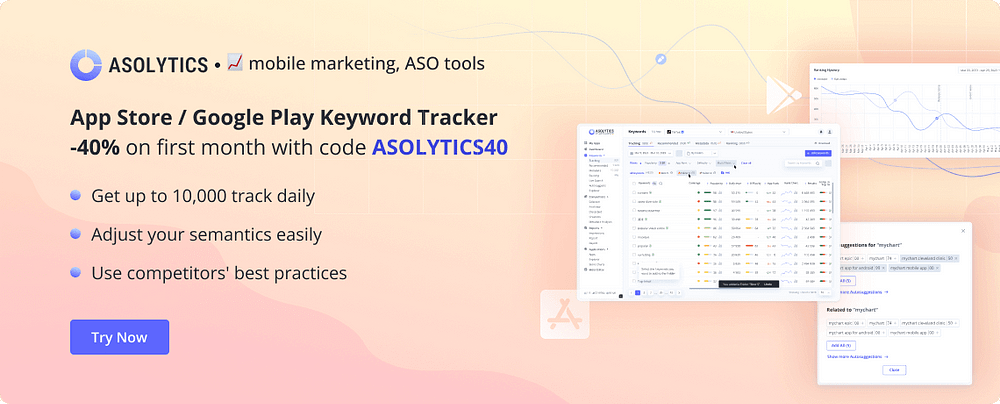
To Conclude
Throughout this guide, we dissected the intricacies of app rankings in the digital marketplace, emphasizing the Apple App Store and Google Play.
We delved into the algorithms that drive app rankings, the differences between the two major platforms, and the actionable strategies to monitor and improve your app’s position. Furthermore, we explored how app rankings can be remarkably sensitive to trends, offering an avenue for strategic optimization and growth.
The journey of app store optimization is ongoing and dynamic, requiring a blend of analytical rigor and creative marketing. It’s clear that success in the app world is not merely about building a great product but also about continuously adapting to the fluid landscape of user preferences, technological advancements, and market trends.
It’s paramount for app developers and marketers to view app store optimization as a marathon, not a sprint. Success in the app stores isn’t just about launching with a bang but maintaining momentum through continuous improvement and responsiveness to the ecosystem’s evolution.
As we conclude this exploration into app ranks and how to influence them, remember that the digital marketplace is an arena of constant competition and innovation. Armed with a deeper understanding of ASO mechanics and strategies, you’re now better equipped to navigate this landscape, pushing your app to new heights and securing the visibility it deserves. Here’s to your app’s ascent up the rankings!
May your apps thrive in the bustling app marketplaces, engaging users and standing out amidst the myriad of options — a testament to your hard work, strategic insights, and adaptability in the fast-paced world of mobile apps.
FAQ
How often do apps rankings change?
The app ranks in both the Apple App Store and Google Play can fluctuate multiple times a day due to factors like user downloads, engagement, ratings, competitor activity, and algorithm updates. Regular monitoring is essential to stay informed of these changes and adapt strategies accordingly.
What is the main difference between app rank in the App Store and Google Play?
The main difference lies in their ranking criteria: the Apple App Store emphasizes app downloads and velocity, user ratings, and keyword relevance, while Google Play prioritizes user engagement metrics device compatibility and uses a more personalized approach to app ranking based on user behavior and preferences.
How to react to an app rank drop?
To address an app rank drop, analyze the cause, improve app quality and user experience, optimize App Store Optimization (ASO) factors, encourage positive reviews, monitor competitor activity, adjust your marketing strategy, and engage in continuous monitoring and adaptation of your strategies.
How to check app rank?
To check app rank, you can use a direct search in the app store, access analytics through platforms like App Store Connect (Apple) or Google Play Console, employ dedicated ASO tools (e.g., Asolytics), and monitor competitor rankings for comparative insights.

